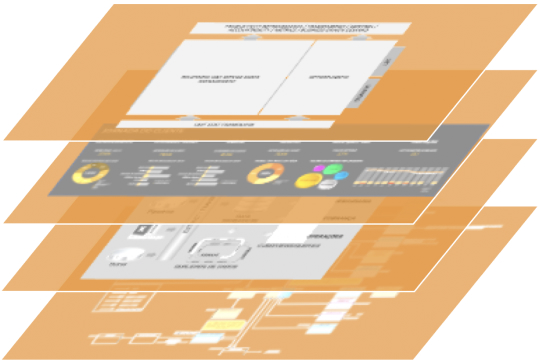TDABC - True Profitability
In an increasingly competitive business landscape, companies must have the costs and profit margins of their products and services well mapped to face competition in the market.

The assertive decisions that lead the company to obtain efficiency gains in its production processes is a dynamic that depends on the availability of detailed and accurate data, and on modern technologies that offer analytical capacity for its managers. The proper functioning of this dynamic is essential for maximizing the profitability of the products and crucial for achieving the company's strategic goals and objectives.
How to establish this dynamic in your company
Inspired by the TDABC* model, Citrine Consulting developed a management model, complementary to the existing accounting management structure in companies. This management model establishes a process of continuous improvement aimed at maximizing the profitability of products and services, through the efficiency of production processes.
*Created by Robert S. Kaplan and Steven Anderson, from Harvard Business School, the TDABC (time-driven activity-base costing) model is a costing model based on activities and time that enables strategic management of the costs of a product or service.

How do you know if TDABC can add value to your company?
We have listed some important questions about cost management and the profitability of the company's products that would be easily answered using the TDABC model and that may reveal gaps in your company's existing management model:
- What indirect costs* impacted product profitability from one period to the next?
- How accurate is the product overhead and profitability information?
- What is the unit cost of the company's products?
- What is the most valuable overhead* item for a given product?
- What is the profitability of each company's product?
- What are the overhead* items related to a given company product?
- What is the cost of IT just to support the company's business (excluding development projects) ?
- Which incidents that occurred in the period impacted the profitability of the product (Ex.: rework, system unavailable) ?
- What was the cause of the increase in the cost of operations and information technology in a given period ?
- What were the cost reduction gains obtained with the delivery of a particular IT project?
- The organization is able to list the activities performed in ascending order of cost ?
- Which current model, whether of workforce (Sourcing), service or technological solution is inefficient or burdens the total cost of the product ?
- Among the operational services that support a given product, which ones are affected by the growth in sales volume?
- Which services are country-specific and burden the total cost and profitability of the product (Note: important when comparing units in other countries) ?
* Indirect Costs are added to the total cost of final products according to predetermined criteria (Ex.: labor, computer resources )
Comparison of TDABC with conventional models
Arraste para o lado e veja todos os dados
| COST AND RESULTS MANAGEMENT MODELS
| ||
|---|---|---|
| Conventional Models | Citrine Consulting (TDABC) | |
| Model | Accounting, Control and Monitoring | Managerial / Strategic, Support for decision making |
| Main features | Identifying inefficiencies / high cost items is not critical Reduced number of indirect cost items Cost items tend to be static (little affected by the production process ) The overhead cost? is low | Identifying inefficiencies / high cost items is critical High number of indirect cost items Cost items are dynamic (affected by the production process ) The overhead cost? is high |
| Management Reportal | Conventional (Printed reports with static data ) | Dashboards (Dill down navigation ) |
| Tools | Corporate Accounting System | Business Intelligence?, Analytics?, Machine Learning, ETL5 |
| Data Structure | Accounting System Database / Data Warehouse | Data Warehouse / Big Data |
| Main benefits | Model already adopted and disseminated in the company Simplification in the use of apportionment rules (Ex.: average overhead value) | Greater detail and accuracy of information on direct and indirect costs and the profitability of products and services Identifies inefficiencies in the production process and cost items that increase the total cost of the product Ease of identifying services that impact the total cost in increasing product sales volume Shows the unit cost of products more accurately |
| Considerations | Lack of detail and imprecision of information on indirect costs and profitability of products Lack of transparency of information consolidation rules General apportionment rules that can distort product cost and profitability analysis Not designed to identify services that are inefficient and/or increase product costs | Establishes more sophisticated standards of analysis, which requires a change in leadership management dynamics It requires discipline in the reporting of hours worked by employees in the operational and IT areas |
1 Conventional models concern the accounting methods used to define the cost per unit (eg work order cost, cost per type of production process)
2 Overhead refers to the general administration costs that must be distributed over the products.
3 Business Intelligence (BI) is a way to group, analyze and explore data and information to identify opportunities and advantages for your business.
4 Analytics is an environment that relies on mathematical, statistical, predictive modeling and machine learning techniques to find patterns and knowledge in information and data to benefit the business.
5 ETL (Extract, Transformation, and Load) are tools that aim to work on data extraction, transformation to meet business needs and loading data into databases.
TDABC Concept
Even profitable companies must have a continuous process of cost reduction and more detailed knowledge of the sources of profit. For this, Citrine Consulting offers the Time-Driven Active-Base Cost (TDABC) 1. The objective of this approach is to offer a service that makes clear the cost and usability of the implemented processes, as well as the profitability of orders, products, and customers.
The most elementary concept behind the TDABC model can be represented by the following equations:
Resource cost
Resource total cost
Available time for the activity
Cost of the activity = Time Unit / Resource Cost / Activity Volume
The implementation of TDABC is based on three phases: process mapping; estimating the costs associated with providing services and/or offering products; aggregation of total costs through the synthesis of cost and time data3.
This approach however does not replace a financial accounting system. The main objective is to provide an effective way to visualize and interpret information, measuring the cost and performance of business processes and their results. .
1 Kaplan, Robert S., Anderson, Steven R. Time-Driven Activity-Base Cost: a simpler and more powerful path to higher profit Ð Hardvard Business School Publishing Corporation
2 Coates, Tomika R., Shared Services Center University of California, Riverside, 2018 NCCI
3 Akhavan, S., Ward, L. & Bozic, K.J. Clin Orthop Relat Res (2016) 474: 8. https://doi.org/10.1007/s11999-015-4214-0
Overview
The correct functioning of the cost management and profitability model of products and services based on TDABC requires action in different layers, as illustrated in the figure below.
Governance
( including: Roles and Responsibilities, organization)
Dashboard (KPIs / Metrics)
(including: drill down function, data correlation)
Aplication / Middleware Software
(including: Time Reporting, Big Data, ETL, Business Rules Engine, Analytics, Reports, Front-end)
Dados
( including: data modeling, data dictionary, data quality framework)

How can we help your company?
Establishing TDABC can take many forms and scopes, depending on the needs of the company. Below is an example of how Citrine Consulting can help :

TDABC - True Profitability
Minimum Viable Product (MVP)
It offers managers the opportunity to conduct a pilot using a modern approach, the TDABC model, for managing the costs and profitability of the company's products and services. This work uses new solutions on an experimental basis. The MVP solution can be expanded if the company is interested.
Why Citrine Consulting?
Citrine Consulting, through its professionals, has extensive knowledge and experience from internal sales, conception, design and successful implementation of the model based on the TDABC approach. We believe in the sum of the experiences of our professionals and the knowledge of the company on the part of our Clients' employees to face the challenges of establishing a new approach to managing the costs and profitability of the company's products and services.
Based on experience in projects for large companies, Citrine Consulting has developed its methodology, frameworks and reference models to help initiatives with its Clients.


